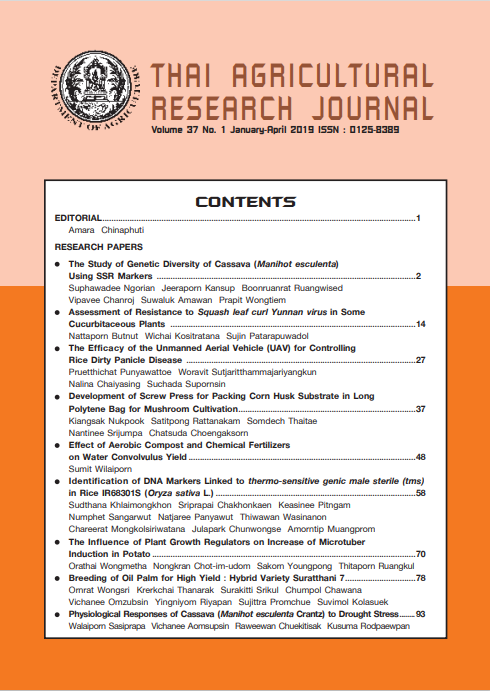Physiological Responses of Cassava (Manihot esculenta Crantz) to Drought Stress
DOI:
https://doi.org/10.14456/thaidoa-agres.2019.12Keywords:
cassava, water stress, climate change, photosynthesisAbstract
Cassava is the drought tolerant crop, however the heat and drought stresses in Thailand during 2013-2015 had caused the delay of crop calendar, replanting, shortening of growing period, and eventual yield variation among cultivars. To understand the responses of cassava varieties under water stress conditions basic information is needed. Three cassava varieties: Rayong 11, Rayong 86-13 and CMR43-08-89 were used in the study of relationship between environmental elements (solar radiation, temperature and relative humidity) and photosynthesis parameters under water stress condition in Kamphaeng Phet Province in 2015. Results showed that, under water stress conditions all varieties had reached maximum net photosynthetic rate (Pn) at 8.00-9.00 a.m. with the values of 14.3- 18.7 µmolCO2 m-2 s-1. After watering, all had reached maximum Pn at the same period but values were higher at 20.8- 24.8 µmolCO2 m-2 s-1. The period of photosynthesis was limited with water stress as confirmed by 6 MAP data, that photosynthesis period was expanded to 10.00 a.m. during rainy season and all varieties showed higher Pn 22.5-26.1 µ molCO2 m-2 s-1. Rayong 86-13 with high starch content, showed smallest Tr during the day and stomatal conductance (gs) highest in early morning and stomata close before the others. Pn showed positive correlation with transpiration rate(Tr), whereas Tr showed negative relation with relative humidity (RH), Photosynthetic Photon Flux Density (PPFD) showed positive relation with air temperature and Tr but negative relation with RH, significantly. Photosynthesis occurred during PPFD 150 – 2,300 mµol m-2 s-1. Under water stress condition, photosynthesis occurred during low PPFD and high RH, but would occur for longer period in non-water stress condition, although low RH 32-40%.
References
นิรนาม. 2560. ความผันแปรและการเปลี่ยนแปลงสภาพภูมิอากาศ พ.ศ. 2558. ศูนย์ภูมิอากาศ สํานักพัฒนาอุตุนิยมวิทยา กรมอุตุนิยมวิทยา. 15 หน้า. แหล่งข้อมูล: https://climate.tmd.go.th/content/file/129 สืบค้น: 10 พฤษภาคม 2560.
นิรนาม. 2561. ตารางมันสำปะหลังโรงงาน : เนื้อที่เพาะปลูก เนื้อที่เก็บเกี่ยว ผลผลิต และผลผลิตต่อไร่ แยกตามชนิดพันธ์ุรายจังหวัด. สำนักงานเศรษฐกิจการเกษตร. แหล่งข้อมูล: https://www.oae.go.th/view/1ตารางแสดงรายละเอียดมันสำปะหลัง/TH-TH สืบค้น: 30 สิงหาคม 2561.
นิรนาม. ไม่ระบุ. พันธุ์และวิธีการปลูกมันสำปะหลัง. เอกสารแนะนำ (แผ่นพับ).ศูนย์วิจัยพืชไร่ระยอง.
พูนพิภพ เกษมทรัพย์ เจษฎา ภัทรเลอพงศ์ เจริญศักดิ์ โรจนฤทธิ์พิเชษฐ์ และเพ็น สายขุนทด. 2537. ความสัมพันธ์ระหว่างตำแหน่งใบ และอัตราการสังเคราะห์แสงสุทธิของใบมันสำปะหลัง 3 พันธุ์. หน้า 105-113. ใน การประชุมทางวิชาการของมหาวิทยาลัยเกษตรศาสตร์ ครั้งที่ 32 สาขาพืช 3-5 กุมภาพันธ์ 2537.
พูนพิภพ เกษมทรัพย์. 2554. ภาวะโลกร้อนและผลกระทบ. ว. วิจัยระบบสาธารณสุข. 3(4):172-187.
วลัยพร ศะศิประภา จิณณจาร์ หาญเศรษฐสุข กุสุมา รอดแผ้วพาล ปฐมพงษ์ วงศ์สุวรรณ์ ดรุณี เพ็งฤกษ์ เสาวรี บําารุง วารีย์ เวรวรณ์ สายนํา้ อุดพ้วย อนุสรณ์ เทียนศิริฤกษ์. 2561. การวิเคราะห์วอเตอร์ฟุตพริ้นท์ของมันสำปะหลังที่มีการจัดการน้ำแตกต่างกัน. ว.วิชาการเกษตร. 36(2): 173-185.
วลัยพร ศะศิประภา และเถลิงศักดิ์ วีระวุฒิ. 2554. รายงานฉบับสมบูรณ์ โครงการเพิ่มผลผลิตมันสำปะหลังโดยการกระจายพันธุ์ดีและท่อนพันธุ์สะอาด. สถาบันวิจัยพืชไร่ ศูนย์สารสนเทศ สำนักวิจัยและพัฒนาการเกษตรเขตที่ 2-6. 106 หน้า.
Aslam M, S.B. Lowe, L.A. Hunt. 1977. Effect of leaf age on photosynthesis and transpiration of cassava (Manihot esculenta). Canadian J. Botany. 55 (17): 2288-2295, 10.1139/b77-260.
Calatayud P.A., E. LLOVERA, J.F BOIS and T. LAMAZE. 2000. Photosynthesis in drought-adapted cassava. Photosynthetica. 38 (1): 97-104.
El-Sharkawy M.A. 2007. Physiological characteristics of cassava tolerance to prolonged drought in the tropics: Implications for breeding cultivars adapted to seasonally dry and semiarid environments. Braz. J. Plant Physiol.19(4):257-286.
El-Sharkawy M.A. 2012. Stress-Tolerant Cassava: The Role of Integrative Ecophysiology-Breeding Research in Crop Improvement. Open J. Soil Science. 2012 (2): 162-186.
Moran R., 1982. Formulae for determination of chlorophyllous pigments extracted with N,N-dimethylformamide. Plant Physiol. 69: 1376-1381.
Paul M.J. and C.H. Foyer. 2001. Sink regulation of photosynthesis. J Exp Bot. 52(360):1383-400. Access from: https://www.ncbi.nlm.nih.gov/pubmed/11457898.
Downloads
Published
How to Cite
Issue
Section
License
Copyright (c) 2019 Thai Agricultural Research Journal

This work is licensed under a Creative Commons Attribution-NonCommercial-NoDerivatives 4.0 International License.
Thai Agricultural Research Journal



